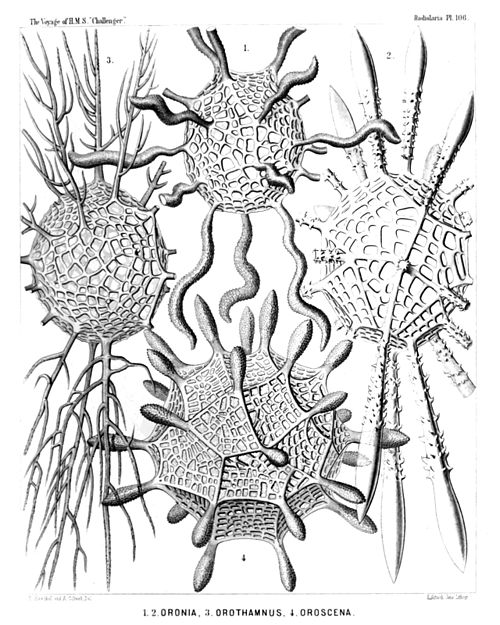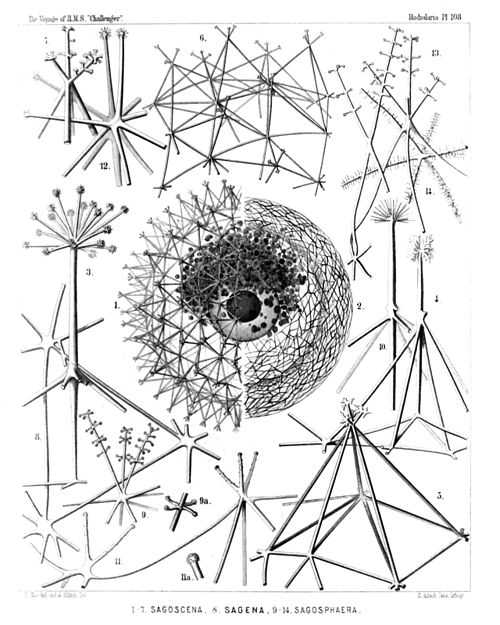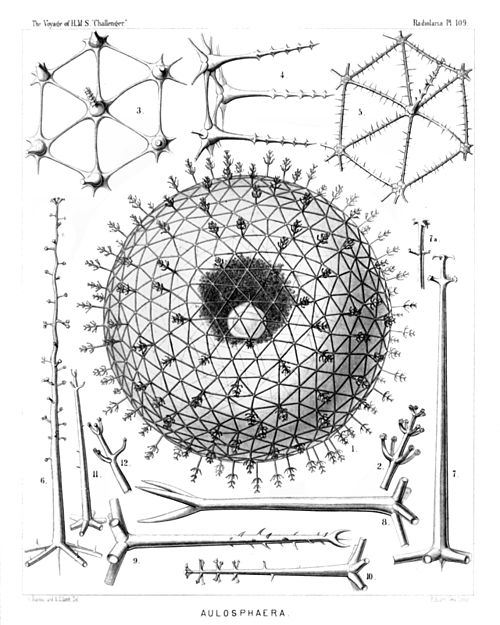| PLATE 103.
|
| Aulacanthida.
|
| Diam.
|
Page.
|
| Fig. 1. Aulographis candelabrum, n. sp.,
|
×
|
100
|
1583
|
| p, The dark phæodium surrounding the central capsule on its oral part; a, a part of the surrounding alveolate calymma, also surrounding the central capsule; s, the veil of tangential needles covering the surface of the alveolate calymma; r, the big radial tubes, seven of which are visible, with an elegant verticil of terminal branches; f, the numerous pseudopodia radiating between the branches. The central capsule exhibits the following parts:—o, Astropyle; u, parapylæ; e, outer membrane; i, inner membrane; v, vacuoles; n, nucleus; l, nucleoli.
|
| Figs. 2-9. Aulographis pandor, n. sp.,
|
×
|
100
|
1577
|
| Distal ends of various radial tubes of a single specimen, exhibiting the extraordinary variability of this species.
|
| Fig. 10. Aulographis furcula, n. sp.,
|
×
|
400
|
1580
|
| A two-branched tube.
|
| Fig. 11. Aulographis furcula, n. sp.,
|
×
|
400
|
1580
|
| A three-branched tube.
|
| Figs. 12, 13. Aulographis bovicornis, n. sp.,
|
×
|
200
|
1577
|
| Two tubes with two branches.
|
| Fig. 14. Aulographis bovicornis, n. sp.,
|
×
|
200
|
1577
|
| A tube with three branches.
|
| Fig. 15. Aulographis triangulum, n. sp.,
|
×
|
200
|
1580
|
| A single tube.
|
| Fig. 16. Aulographis taumorpha, n. sp.,
|
×
|
300
|
1577
|
| Two tubes, each with two branches.
|
| Fig. 17. Aulographis triglochin, n. sp.,
|
×
|
300
|
1578
|
| A tube with three branches.
|
| Figs. 18, 19. Aulographis hexancistra, n. sp.,
|
×
|
300
|
1581
|
| Distal end of two tubes (one with four, the other with five terminal branches).
|
| Fig. 20. Aulographis dentata, n. sp.,
|
×
|
200
|
1582
|
| Distal end of a single tube.
|
| Fig. 21. Aulographis ancorata, n. sp.,
|
×
|
300
|
1578
|
| Two tubes, each with four recurved branches.
|
| Fig. 22. Aulographis tetrancistra, n. sp.,
|
×
|
300
|
1581
|
| A single tube.
|
| Fig. 23. Aulographis stellata, n. sp.,
|
×
|
300
|
1578
|
| a and b, Two rudimentary or incompletely developed tubes; c, a well-developed tube of the usual form.
|
| Fig. 24. Aulographis asteriscus, n. sp.,
|
×
|
300
|
1581
|
| Terminal verticil of a single tube.
|
| Fig. 25. Aulographis cruciata, n. sp.,
|
×
|
300
|
1578
|
| Distal end of a single tube.
|
| Fig. 26. Aulographis pulvinata, n. sp.,
|
×
|
400
|
1582
|
| Distal end of a single tube.
|
| Fig. 27. Aulographis serrulata, n. sp.,
|
×
|
400
|
1582
|
| Distal end of a single tube.
|










